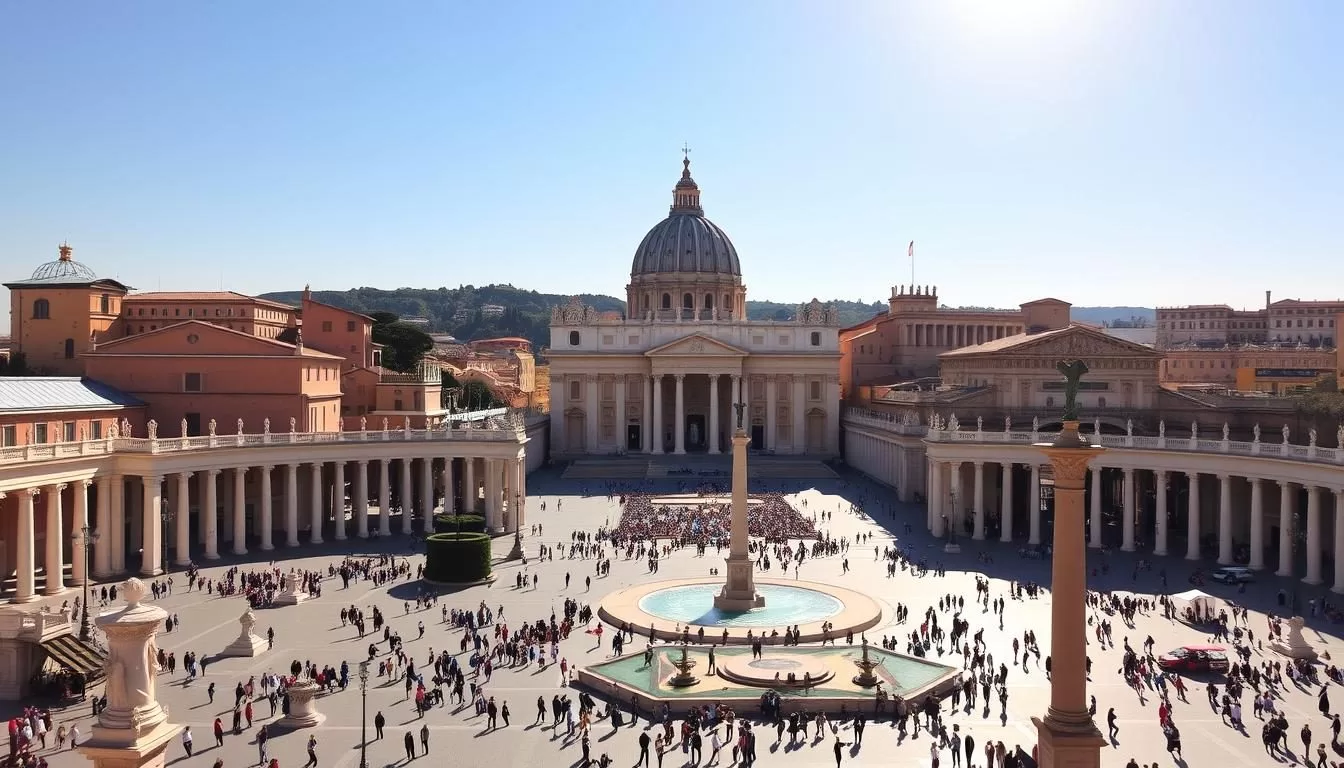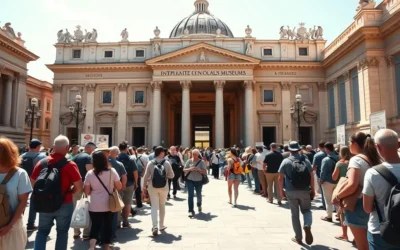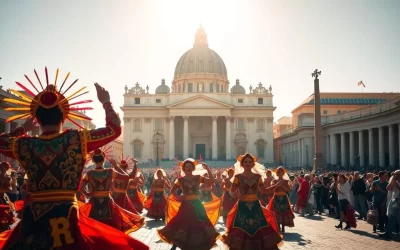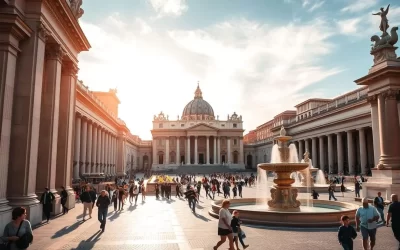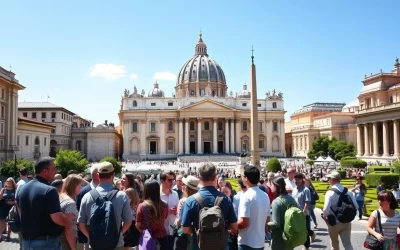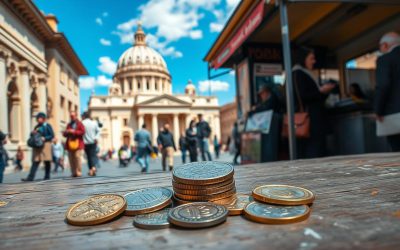✓ Accommodations✓ Flights✓ Rental Cars
Welcome to the world’s smallest sovereign state, a place where history, art, and spirituality converge. As you plan your visit to Vatican City, you’re about to experience some of the most breathtaking attractions in Rome.
With just over 500 residents, this unique city-state is home to numerous iconic landmarks, including St. Peter’s Basilica and the Vatican Museums, which house the renowned Sistine Chapel. As you explore these incredible sites, you’ll discover the rich history and artistic treasures that make Vatican City a must-visit destination.
To make the most of your visit, we’ll guide you through the top attractions, provide insider tips on avoiding long lines, and help you navigate the must-see highlights. Whether you’re planning a day trip or a longer stay, this guide will ensure you experience the best of Vatican City.
Discovering Vatican City: What You Need to Know
As the center of the Catholic Church, Vatican City is steeped in history, art, and architecture that spans centuries. To truly appreciate this unique city-state, it’s essential to understand its background and significance.
Quick Facts About Vatican City
Vatican City is the world’s smallest internationally recognized sovereign state, both by area and population. Here are some key facts:
- Vatican City’s history as an independent state began in 1929 with the Lateran Treaty.
- The area was originally the site of St. Peter’s martyrdom in approximately 64 CE.
- The current St. Peter’s Basilica was constructed between 1506 and 1626.
- The Vatican Museums house one of the world’s most extensive art collections.
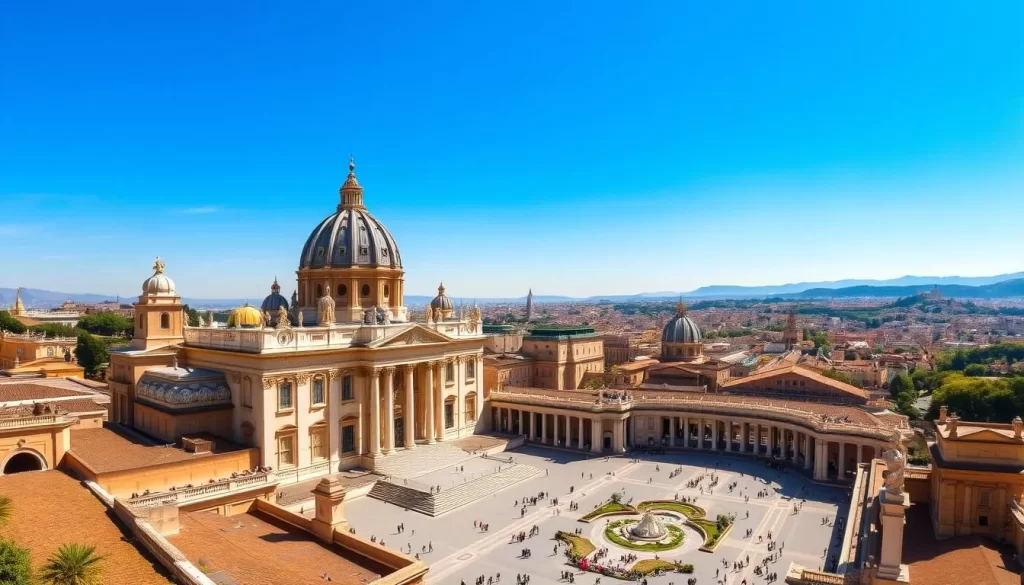
Brief History of the World’s Smallest State
The history of Vatican City is deeply intertwined with the history of the Catholic Church. The construction of defensive walls by Pope Leo IV in the 9th century marked a significant period in its development, following the sacking of Old St. Peter’s Basilica in 846. These walls are still visible today, particularly in the Vatican Gardens. The evolution of Vatican City from ancient Roman times to its current status as an independent state is a testament to its enduring history and significance in the world.
Planning Your Vatican Visit: Essential Tips
A well-planned visit to Vatican City can enhance your overall experience significantly. To ensure you make the most of your trip, it’s essential to be prepared with the right information.
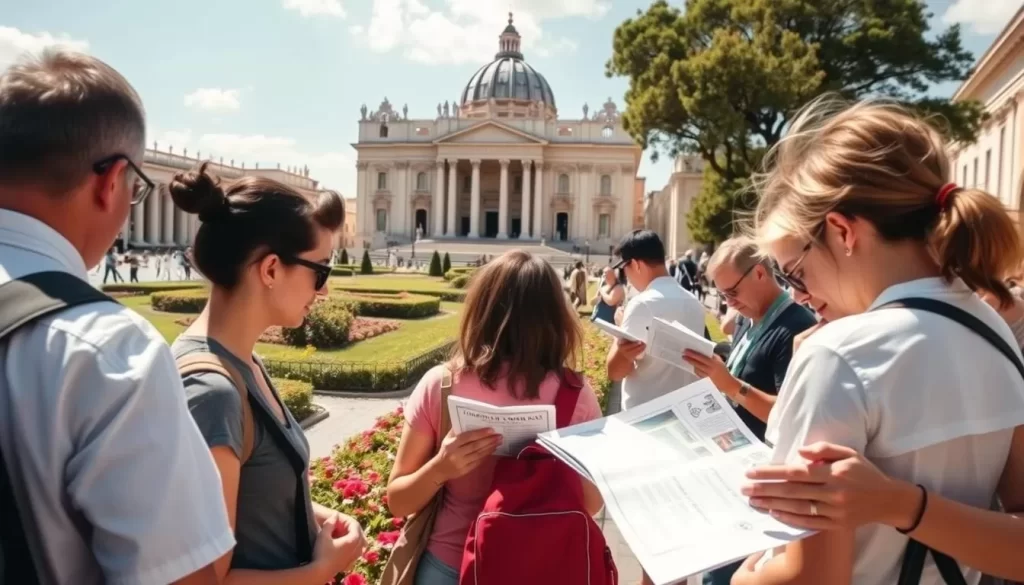
Best Time to Visit Vatican City
The best time to visit Vatican City is crucial for a pleasant experience. Avoiding peak tourist season can help you navigate the attractions more comfortably. The Vatican Museums, in particular, are less crowded during the off-season, making it easier to explore the Sistine Chapel and other galleries without the crowds.
Additionally, visiting early in the morning or later in the afternoon can help you avoid the peak tourist hours. It’s also worth noting that the Vatican Museums are closed on Sundays, except for the last Sunday of the month when they are open for free.
Dress Code Requirements
When visiting Vatican City, it’s essential to adhere to the dress code requirements. Both men and women should ensure their shoulders are covered, and clothing should not be too revealing. This rule applies to both St. Peter’s Basilica and the Vatican Museums. Wearing comfortable shoes is also advisable, as you’ll be doing a lot of walking.
How Much Time to Allocate
Allocating the right amount of time for your visit is vital. For a basic visit to the Vatican Museums, Sistine Chapel, and St. Peter’s Basilica, plan to spend at least 3-4 hours. However, for a more thorough experience, consider allocating a full day (6-8 hours) to explore these attractions without feeling rushed.
- The Vatican Museums alone require a minimum of 2 hours for a quick visit, though art enthusiasts could easily spend 3-4 hours here.
- St. Peter’s Basilica typically takes 1-2 hours to explore properly, not including potential waiting time in security lines.
- If you plan to climb the dome or visit the Vatican Grottoes, add an additional 1-2 hours to your itinerary.
St. Peter’s Basilica: The Heart of Catholicism

As you step into St. Peter’s Basilica, you’re immediately enveloped in a world of spiritual and artistic grandeur. This magnificent structure is not only the heart of Catholicism but also a testament to the artistic and architectural prowess of the Renaissance era.
Highlights Inside the Basilica
The basilica is home to numerous breathtaking masterpieces. Among the highlights are Michelangelo’s powerful Pietà and Bernini’s magnificent Baldacchino canopy, which marks the grave of the apostle St. Peter. These works of art are not just visually stunning but also deeply significant to the religious and historical context of the basilica.
Some of the key highlights include the intricate mosaics, stunning stained glass windows, and the numerous sculptures and artworks that adorn the interior. Each of these elements contributes to the basilica’s status as a sacred and culturally rich destination.
Michelangelo’s Pietà
Michelangelo’s Pietà is one of the basilica’s most treasured possessions. This sculpture, depicting the Virgin Mary mourning over the body of Jesus Christ, is renowned for its emotional intensity and technical mastery. Crafted when Michelangelo was just 24, the Pietà remains one of his most celebrated works, captivating visitors with its beauty and pathos.
Bernini’s Baldachin
Bernini’s Baldachin stands as a monumental bronze canopy directly under the dome of St. Peter’s Basilica, marking the location of St. Peter’s tomb below. Created between 1623 and 1634, this 29-meter-tall masterpiece combines elements of architecture and sculpture in Bernini’s signature Baroque style. The twisted columns draw inspiration from the ancient columns that supposedly adorned Solomon’s Temple in Jerusalem.
The Baldachin has recently been restored to its original glory, with its intricate details and gold accents now fully appreciable by visitors. It serves both as a visual focal point within the massive basilica and as a ceremonial covering for the Papal Altar, where only the Pope may celebrate Mass.
Climbing St. Peter’s Dome: Panoramic Views
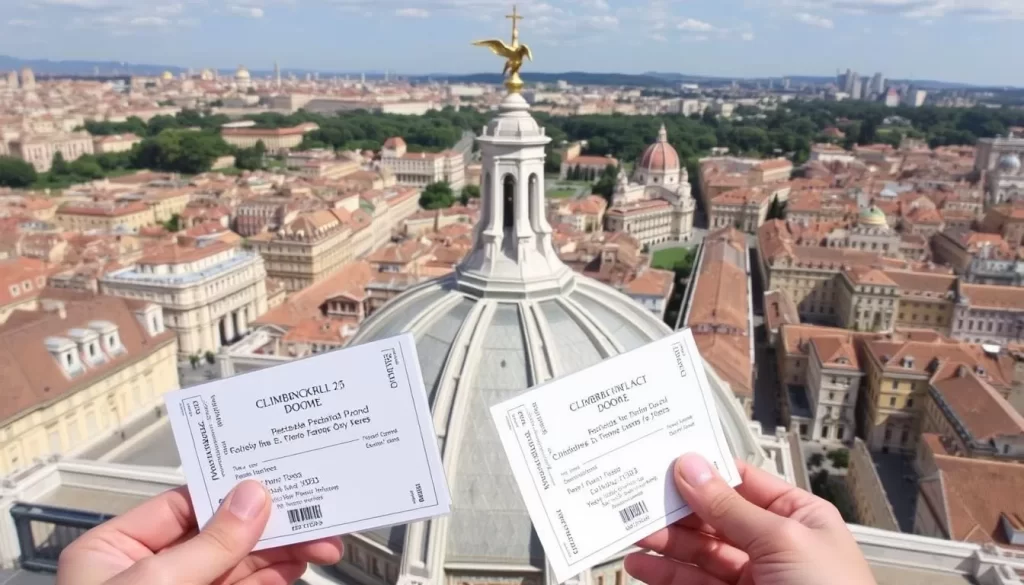
For a unique perspective on Rome, consider climbing St. Peter’s Dome in Vatican City. This iconic landmark offers more than just a religious experience; it’s an architectural marvel that rewards visitors with breathtaking views from the top.
What to Expect During the Climb
Climbing St. Peter’s Dome is an adventure that requires some effort, but the panoramic views from the top are well worth it. You’ll navigate through a narrow staircase, but the experience is generally manageable for most visitors. As you ascend, you’ll be treated to glimpses of Vatican City’s intricate architecture and, upon reaching the top, a spectacular view of Rome.
Best Time for Dome Access
The best time to climb St. Peter’s Dome is early morning when the basilica opens at 7:00 AM, helping you avoid the crowds and the midday heat. Alternatively, consider a late afternoon climb after 3:00 PM for a less crowded experience and beautiful lighting for photographs. Avoid midday hours, especially during summer, for a more comfortable climb.
Vatican Museums: Artistic Treasures
As you explore Vatican City, the Vatican Museums stand out as a treasure trove of artistic and historical riches. With a collection that spans centuries, the museums are a must-visit for anyone interested in art, history, or culture.
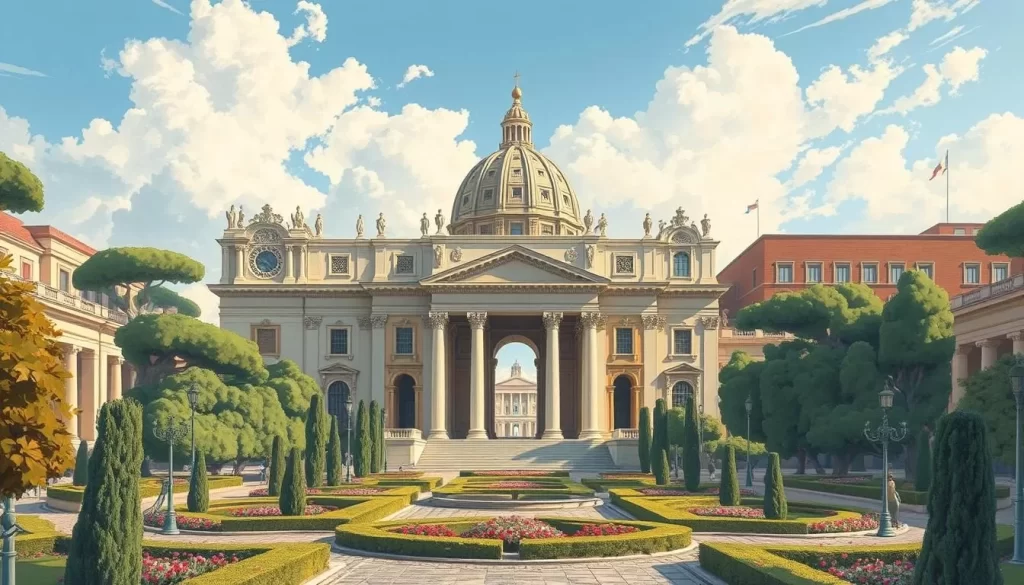
Gallery of Maps
The Gallery of Maps is a stunning example of the Vatican’s rich history, featuring intricately painted maps of Italy and the surrounding regions. This gallery is not just a treat for the eyes but also a valuable resource for understanding the historical context of the Vatican’s influence.
Raphael Rooms
The Raphael Rooms are a highlight of the Vatican Museums, showcasing some of the most exquisite Renaissance art. These rooms were painted by Raphael and his pupils, featuring frescoes that depict various scenes from history and mythology. The rooms are a testament to the artistic genius of Raphael and the era’s cultural achievements.
Egyptian and Etruscan Museums
Beyond the famous Sistine Chapel, the Vatican Museums house other remarkable collections, including the Egyptian and Etruscan Museums. The Gregorian Egyptian Museum, founded by Pope Gregory XVI in 1839, displays artifacts dating back to ancient Egypt, including mummies, sarcophagi, and statues from as early as 3000 BCE. The Gregorian Etruscan Museum features an impressive collection of artifacts from the pre-Roman Etruscan civilization, including the Mars of Todi, a life-sized bronze warrior statue, and numerous examples of intricate Etruscan goldwork and pottery.
These collections demonstrate the Vatican’s interest in preserving not just Christian heritage but also the broader cultural and historical legacy of Mediterranean civilizations. Visitors can gain a deeper understanding of the historical and cultural contexts that have shaped the region.
When planning your visit to the Vatican Museums, it’s worth noting that there isn’t a ticket or tour that includes a shortcut. This means that visitors should be prepared to navigate the extensive collections without a quick bypass. However, the Vatican Museums offer guided tours that can enhance your experience and provide valuable insights into the artworks and artifacts on display.
The Sistine Chapel: Michelangelo’s Masterpiece
Your visit to the Vatican Museums will be incomplete without witnessing the splendor of the Sistine Chapel, where Michelangelo’s artistry shines bright. As one of the most famous art destinations in the world, the Sistine Chapel is a must-see attraction on your tour.
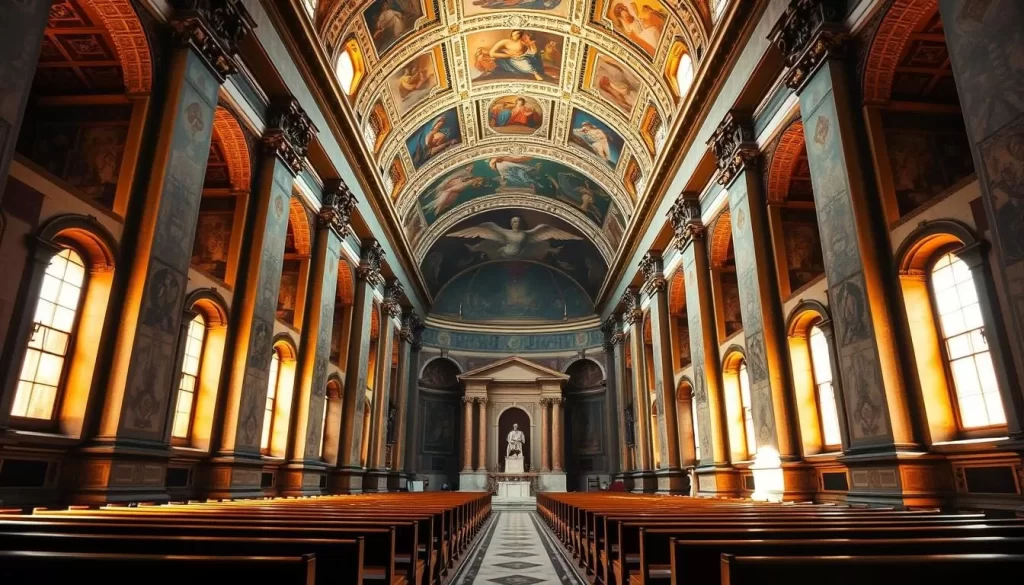
Understanding the Ceiling Frescoes
The ceiling of the Sistine Chapel, painted by Michelangelo Buonarroti between 1508 and 1512, is a breathtaking spectacle. The frescoes depict scenes from the Book of Genesis, including the famous Creation of Adam and The Great Flood. Michelangelo’s work on the ceiling is considered one of the greatest artistic achievements of all time, showcasing his mastery of color, composition, and narrative.
As you gaze upon the ceiling, you’ll notice the intricate details and the vivid colors that bring the biblical stories to life. The frescoes are not just beautiful works of art; they are also deeply symbolic, representing the theological and philosophical themes of the Renaissance.
The Last Judgment
Nearly 25 years after completing the ceiling frescoes, Michelangelo returned to the Sistine Chapel to work on another masterpiece: The Last Judgment. Painted on the altar wall between 1536 and 1541, this massive fresco depicts Christ as the judge of the world, surrounded by saints, angels, and the souls of humanity being separated into the saved and the damned.
Unlike the colorful ceiling, The Last Judgment uses a more limited palette dominated by blues, creating a dramatic and somber atmosphere. The fresco was controversial upon its completion due to the numerous nude figures, leading to the “Fig Leaf Campaign” where later artists added drapery to cover the nudity. When you visit the Sistine Chapel, take time to study both the ceiling and The Last Judgment separately, as they represent different periods in Michelangelo’s artistic development and theological thinking.
Vatican City, Vatican: Best Things to Do – Top Picks
As you plan your visit to Vatican City, you’ll want to prioritize the top attractions that make this unique city-state a must-see destination. With a rich history, stunning art, and spiritual significance, Vatican City is a treasure trove of experiences waiting to be explored.
Must-See Attractions
The Vatican is home to numerous iconic landmarks that are a must-visit. The Vatican Museums are a highlight, housing some of the world’s most renowned art and artifacts. You can explore the Gallery of Maps, Raphael Rooms, and Egyptian and Etruscan Museums, among other treasures. Be sure to visit the Sistine Chapel, famous for Michelangelo’s breathtaking ceiling frescoes.
- The Vatican Pinacoteca (Art Gallery) features masterpieces by Raphael, Caravaggio, and Leonardo da Vinci.
- The Vatican’s collection of modern and contemporary art is also worth exploring.
With so much to see, it’s essential to plan your visit to the Vatican Museums carefully. Consider a guided tour to make the most of your time and gain deeper insights into the art and history on display.
Hidden Gems Within Vatican Walls
Beyond the famous attractions, Vatican City holds many hidden gems waiting to be discovered. You can explore the Vatican Gardens, a lush oasis behind the Leonine walls, built in the 9th century. The gardens are a peaceful retreat, featuring exotic plants, sculptures, and fountains.
- The Bramante Staircase, a double-helix spiral staircase, is a unique architectural experience accessible on special extended Vatican Museums tours.
- The Niccoline Chapel, decorated with frescoes by Fra Angelico, is a beautiful small space that requires special permission to visit.
- The Vatican’s ancient walls, dating back to the 9th century, can be explored during special tours, offering insight into the city-state’s defensive history.
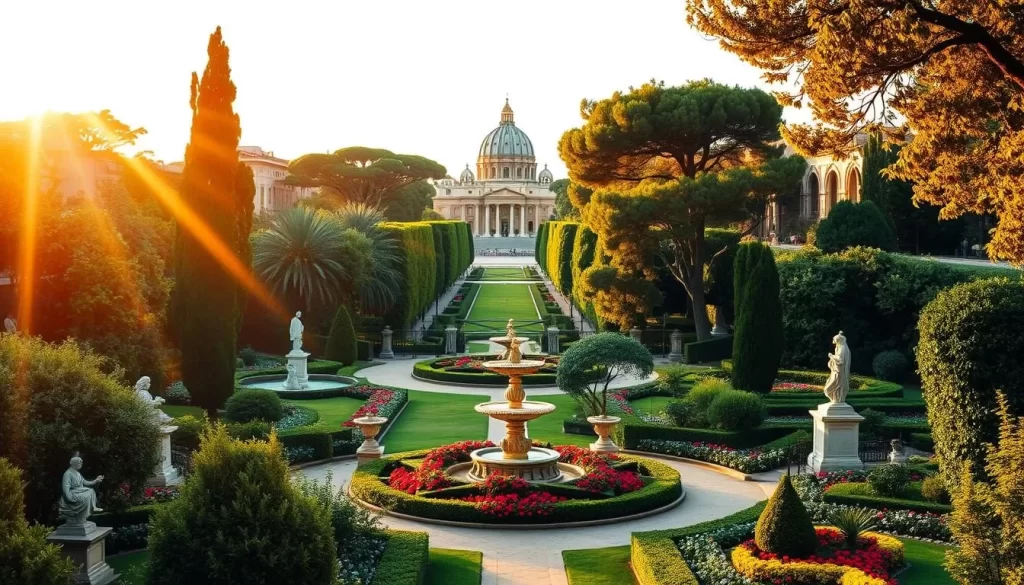
These hidden gems offer a deeper understanding of Vatican City’s rich history, art, and spirituality, making your visit even more memorable.
Vatican Gardens: A Peaceful Retreat
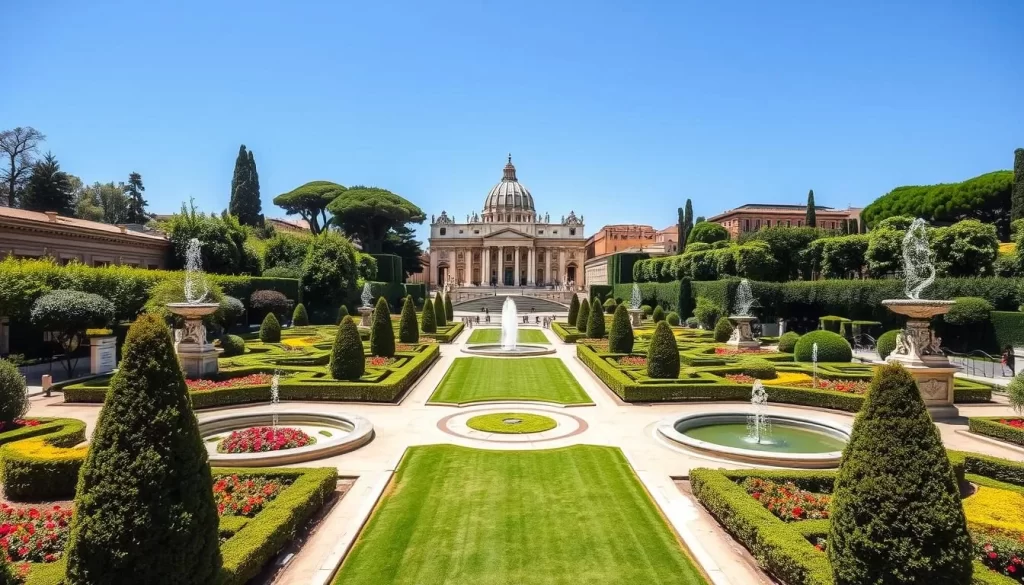
Escape to the serene Vatican Gardens, a tranquil oasis within the heart of Vatican City. The Vatican Gardens are a must-visit attraction, offering a unique blend of natural beauty and historical significance.
How to Book a Garden Tour
To explore the Gardens, you need to book a guided tour in advance. These tours provide a comprehensive insight into the history and significance of the gardens. You can book your tour through the official Vatican Museums website or through authorized tour operators.
What You’ll See in the Gardens
As you stroll through the Vatican Gardens, you’ll discover a variety of attractions. The gardens cover nearly 23 hectares and feature meticulously maintained Renaissance and Baroque landscaping. You’ll see the medieval St. John’s Tower, numerous fountains, and various papal coat of arms. The Pope has used these gardens as a refuge since the Middle Ages, and they continue to offer a peaceful escape. The gardens are surrounded by ancient walls that add to their mystique.
The gardens are also home to several small buildings, including the Vatican Radio station and the Casina Pio IV, a beautiful Renaissance villa. Throughout your tour, you’ll encounter religious statues and shrines, reflecting the spiritual nature of this peaceful retreat. The elevated positions within the gardens offer spectacular views of St. Peter’s Dome, making it a photographer’s dream.
St. Peter’s Square: Bernini’s Grand Design
As you step into Vatican City, one of the most iconic and awe-inspiring places you’ll encounter is St. Peter’s Square. This grand square, designed by Bernini, is not only a masterpiece of Baroque architecture but also a significant religious hub. It’s the only part of Vatican City you can visit without any tickets or queuing, making it an accessible destination for all.
The Symbolic Layout
The layout of St. Peter’s Square is rich in symbolism. The colonnade, designed by Bernini, is meant to symbolize the embracing arms of the Catholic Church, welcoming pilgrims and visitors from around the world. The square itself is an engineering marvel, with its elliptical design and massive scale creating an imposing yet harmonious atmosphere.
The symbolic layout is further emphasized by the presence of the Egyptian obelisk in the center, which adds to the square’s grandeur and historical significance. The obelisk, originally from Egypt, was moved to its current location in the 16th century, further enriching the square’s cultural and religious heritage.
| Feature | Description | Significance |
|---|---|---|
| Colonnade | Designed by Bernini, it symbolizes the embracing arms of the Catholic Church. | Welcomes pilgrims and visitors worldwide. |
| Egyptian Obelisk | Originally from Egypt, moved to St. Peter’s Square in the 16th century. | Adds to the square’s grandeur and historical significance. |
Papal Audiences and Blessings
St. Peter’s Square is not just a beautiful place; it’s also a hub of religious activity. The Pope holds regular public audiences here on Wednesday mornings, typically at 10:30 AM, drawing large crowds who gather to receive his blessing. While free tickets are required for seated sections, you can still attend by standing at the back of the square, though arriving early is recommended.
On Sundays at noon, the Pope appears at his window to deliver the Angelus prayer and blessing, an event that requires no tickets and typically lasts about 20 minutes. During special occasions like Easter and Christmas, the Pope delivers “Urbi et Orbi” blessings from the central balcony of St. Peter’s Basilica to the massive crowds gathered in the square.
Vatican Grottoes and Necropolis: Papal Tombs
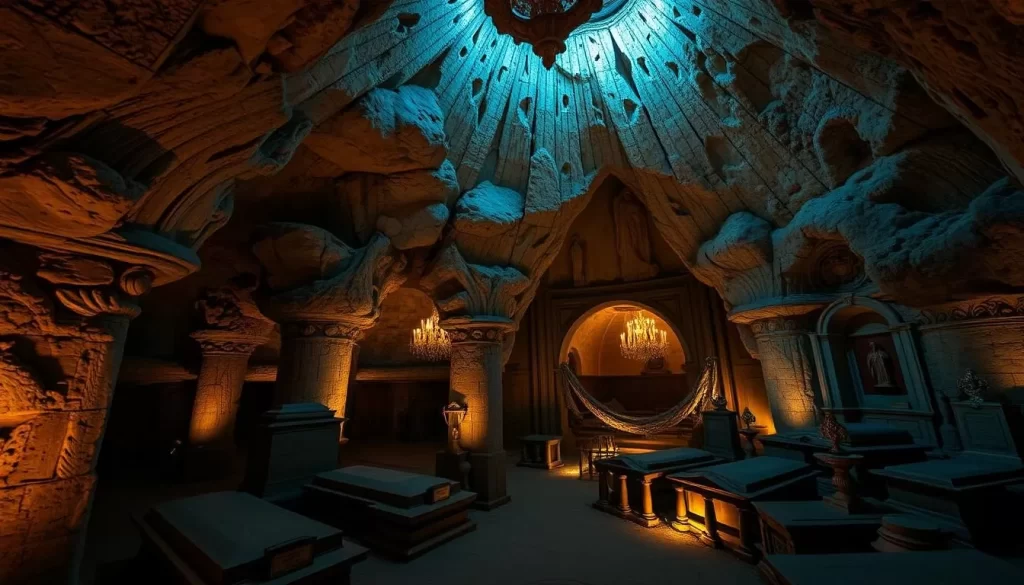
Beneath the grandeur of St. Peter’s Basilica lies a lesser-known yet profoundly significant site: the Vatican Grottoes and Necropolis. While many visitors flock to see the Basilica, few explore the historical and spiritual depths offered by these underground areas.
Visiting the Vatican Grottoes
The Vatican Grottoes, located beneath St. Peter’s Basilica, contain the tombs of many popes. Visiting this area provides a unique insight into the history of the Catholic Church and its leaders. The Grottoes are a place of reverence and historical significance, housing tombs that date back centuries.
The Scavi Tour to St. Peter’s Tomb
The Scavi Tour, also known as the Vatican Necropolis tour, is a special experience that takes visitors to the site believed to be the tomb of St. Peter. This 90-minute guided tour is limited to 250 visitors per day, divided into small groups of 12, making it essential to book well in advance. The tour involves walking through ancient Roman mausoleums and culminates at the site identified as St. Peter’s burial place beneath Peter’s Basilica. Due to the nature of the site, visitors must be prepared for narrow passages, uneven floors, and high humidity, and children under 15 are not permitted.
To undertake this extraordinary journey, one must email the Excavations Office (scavi@fsp.va) to reserve a spot on the tour. It’s a once-in-a-lifetime experience that offers a deep dive into history and spirituality.
Skipping the Lines: Tickets and Tours

Maximizing your Vatican City experience requires some planning, particularly when it comes to avoiding long lines. Visitors can save time and enhance their overall experience by understanding the options available for skipping the lines.
Pre-Booking Vatican Museum Tickets
One effective way to avoid waiting in line is to pre-book your Vatican Museum tickets. By doing so, you can bypass the ticket counter and head straight to the security check. This simple step can save you a significant amount of time, especially during peak travel seasons.
The Vatican Museums offer various types of tickets, including guided tours and skip-the-line options. When purchasing tickets online, ensure that you select the correct type to avoid any confusion.
Guided Tour Options
Guided tours are another excellent way to navigate the Vatican City efficiently. Not only do they provide valuable insights into the history and art of the museums, but they also often include skip-the-line access. When booking a guided tour, look for options that include the Sistine Chapel and St. Peter’s Basilica to make the most of your visit.
Some guided tours offer additional benefits, such as privileged access to restricted areas or expert guides who can provide in-depth information about the Vatican Museums.
The Vatican Museums to St. Peter’s Shortcut
For visitors on guided tours that include both the Vatican Museums and St. Peter’s Basilica, there is a convenient shortcut available. As of 2024, this shortcut allows visitors to bypass the long security lines at St. Peter’s Basilica’s main entrance, potentially saving hours of waiting time.
To use this shortcut, ensure that your tour includes “direct access” or “privileged access” to St. Peter’s Basilica from the Sistine Chapel. The shortcut is available from 9:30 am to 5 or 5:30 pm, depending on the time of year.
Beyond Vatican Walls: Nearby Attractions
Once you’ve explored the Vatican, take a stroll into the nearby areas to discover Rome’s diverse charm. The area surrounding Vatican City is rich in history, architecture, and culture, offering visitors a chance to experience more of what Rome has to offer.
Castel Sant’Angelo
A short walk from the Vatican, Castel Sant’Angelo is a former fortress and mausoleum that offers panoramic views of the city. Originally built as a tomb for Emperor Hadrian, it has served various purposes over the centuries, including as a fortress and papal residence. You can walk across the Passetto di Borgo, a secret passageway that connects Castel Sant’Angelo to the Vatican, adding to its historical allure.
Borgo Neighborhood
The Borgo Neighborhood is a charming area that surrounds the Vatican City, offering a glimpse into traditional Rome. As you walk through its narrow streets, you’ll discover quaint shops, local eateries, and historic buildings. This neighborhood provides a more subdued atmosphere compared to the bustling streets of central Rome, making it a pleasant place to explore.
Prati District Shopping
The Prati district is one of Rome’s premier shopping destinations, located just north of the Vatican. Via Cola di Rienzo, the district’s main shopping street, is lined with a mix of international brands and local boutiques. You can easily walk here from St. Peter’s Square in about 5-10 minutes, making it a convenient way to spend an afternoon shopping. The area is also known for its excellent gelaterias, cafes, and restaurants, where you can enjoy a meal away from the tourist crowds.
| Attraction | Distance from Vatican | Time to Explore |
|---|---|---|
| Castel Sant’Angelo | 0.5 km | 2 hours |
| Borgo Neighborhood | 0.2 km | 1-2 hours |
| Prati District | 0.5 km | 2-3 hours |
Where to Eat Near Vatican City
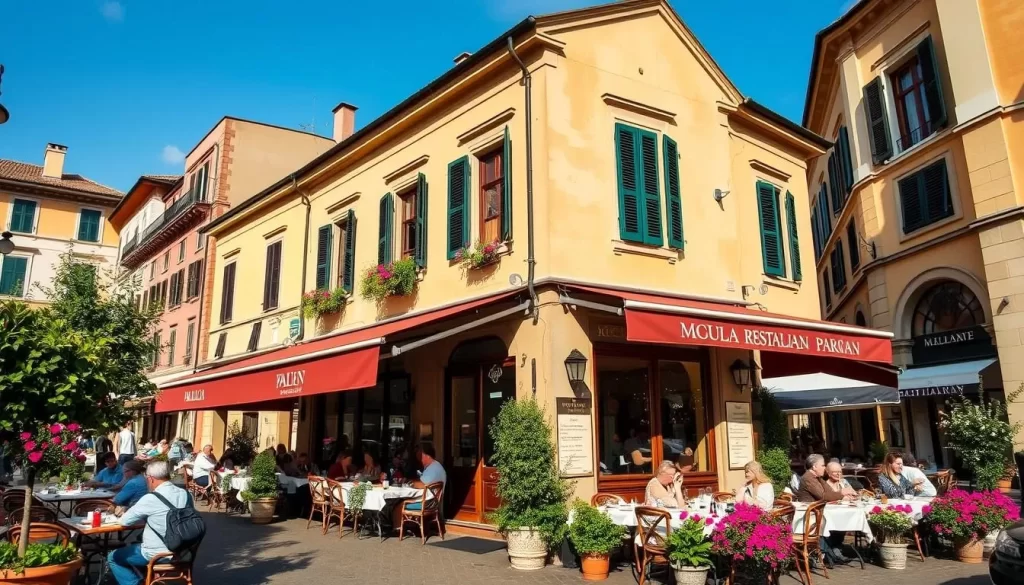
As you plan your visit to the Vatican, consider the variety of restaurants and cafes in the nearby Borgo district. The area is known for its medieval character, with narrow lanes and charming squares, making it a lovely place to unwind after a tour of the Vatican Museums.
Authentic Italian Restaurants
The Borgo neighborhood is home to many authentic Italian restaurants. One standout is Pastificio del Borgo, located on the bustling Borgo Pio, where you can sample some of the city’s best carbonara. The area is filled with taverns and hostelries that cater to travelers visiting the Vatican, offering a range of traditional Italian dishes.
When you have time to explore, you’ll discover that the Borgo has retained its medieval charm, with ivy-strewn facades and tinkling fountains. This makes it an ideal place to enjoy a meal after visiting St. Peter’s Basilica and the Vatican Museums.
Quick Bites and Cafes
If you’re looking for a quick bite or coffee, there are several great options near the Vatican Museums. Caffè Pergamino on Via Scipioni is a 10-minute walk away and serves some of Rome’s best espresso. For a gourmet pizza al taglio, try Pizzarium, created by famous pizza chef Gabriele Bonci, which is perfect for a quick lunch between visiting the Vatican Museums and St. Peter’s Basilica.
Other great options include Old Bridge Gelateria for some of Rome’s most beloved gelato, and Castroni on Via Cola di Rienzo for a traditional Italian breakfast. If you’re looking for a quick sandwich, Duecento Gradi near Castel Sant’Angelo offers creative panini made with high-quality ingredients, ideal for a picnic in nearby Adriano Park. You’ll find many things to enjoy in this area.
Practical Information for Visitors
To ensure a smooth and enjoyable experience in Vatican City, here are some key details you should know.
Vatican City Opening Hours
The Vatican City attractions have varying opening hours, so it’s crucial to plan ahead. Generally, the Vatican Museums are open from 9:00 AM to 6:00 PM, but they are closed on Sundays, except for the last Sunday of the month. St. Peter’s Basilica is open daily from 7:00 AM to 7:00 PM. It’s always a good idea to check the official Vatican website for the most up-to-date information before your visit.
Bathroom Locations
Finding a restroom in Vatican City can be challenging, but there are facilities available. You can find bathrooms near the Vatican Museums’ entrance, inside the museums, and near St. Peter’s Basilica. Be prepared for potential lines, especially during peak travel seasons.
Vatican Post Office
Don’t miss a visit to the Vatican Post Office if you want to mail postcards. The Vatican operates its own postal service, known as Poste Vaticane, which is more efficient than the Italian postal system. You can find post offices in St. Peter’s Square, inside the Vatican Museums, and at the top of St. Peter’s Dome. Some key benefits include:
- Vatican stamps are considered collectors’ items, featuring beautiful designs that highlight Vatican art treasures or important religious events.
- Postcards sent from the Vatican typically arrive at international destinations faster than those sent from regular Italian post offices.
- The post offices also sell Vatican euros, which are legal tender throughout the Eurozone but are produced in limited quantities, making them desirable souvenirs for coin collectors.
Conclusion
With its unparalleled concentration of treasures, Vatican City is a must-visit destination for any traveler. When visiting Vatican, you can explore both St. Peter’s Basilica and the Vatican Museums in a single day, though art enthusiasts may prefer to spread their visit across multiple days. To make the most of your visit, plan ahead by booking tickets or tours in advance and dressing appropriately.
Discover the Sistine Chapel and other famous attractions, as well as lesser-known treasures like the Vatican Gardens. Whether you’re drawn by religious devotion, artistic appreciation, or historical interest, a visit to Vatican City offers a profound and memorable experience.
The above is subject to change.
Check back often to TRAVEL.COM for the latest travel tips and deals.
